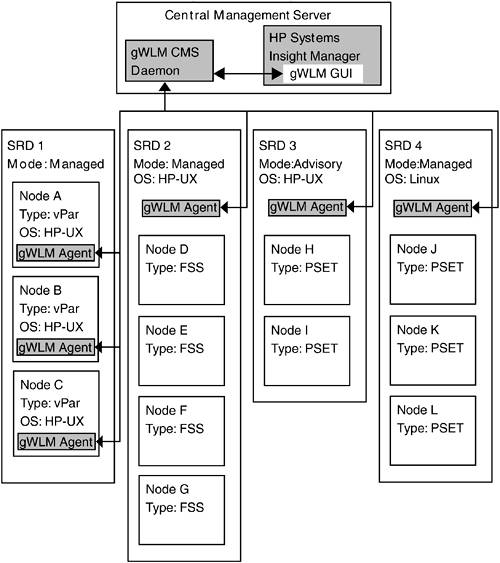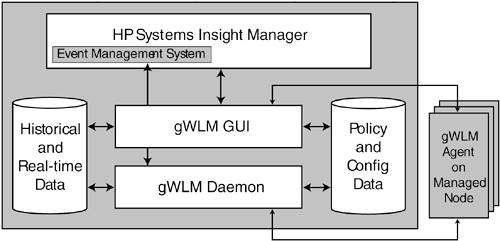Global Workload Manager Overview
| Global Workload Manager is the second-generation workload management application in HP's Virtual Server Environment. gWLM's architecture provides a centralized management model for defining workloads and their associated policies. This makes possible resource sharing by utilizing several of the dynamic system capabilities in HP's Virtual Server Environment such as virtual partitions, processor sets, and fair-share schedule groups. The association of policies with workloads increases system utilization by increasing the level of resource-sharing between workloads. Policies can be used instead to isolate resources to specific workloads. Figure 19-1 shows an example configuration for gWLM. This example illustrates gWLM's flexibility and power in its management of workloads. The Central Management Server (CMS) hosts the HP Systems Insight Manager application, the gWLM CMS daemon, and the gWLM web-based graphical user interface (GUI). The gWLM GUI is tightly integrated with HP Systems Insight Manager and communicates with the gWLM CMS daemon. The gWLM CMS daemon communicates with the gWLM agents running on each operating system under the control of gWLM. Figure 19-1. Global Workload Manager Example Configurations
In the CMS depicted in the diagram, four Shared Resource Domains are being managed. The first Shared Resource Domain is SRD 1. This SRD is in managed mode, which means that gWLM is monitoring workload resource utilization and is actively making changes to resource allocation for each compartment. SRD 1 contains three vPars that are all running HP-UX. Notice that the gWLM CMS daemon communicates with a gWLM managed node agent running on each of the vPars. Important Shared Resource Domains containing vPars must reside within the same nPar or stand-alone server. This is because gWLM must have the ability to migrate resources between the compartments within the Shared Resource Domain. The second SRD shown is SRD 2, which consists of four FSS groups running within a single operating system. Since all of the compartments are contained within a single operating system, only one gWLM agent is required on the system. The gWLM CMS daemon communicates with the gWLM agent to send configuration changes and collect historical utilization data. The gWLM agent is responsible for adjusting the size of each compartment based on the policies and resource utilization metrics of its workloads. This SRD is also in managed mode. The third SRD, SRD 3, is in advisory mode, which means that gWLM will not make changes to the PSET compartments on this system. Instead, gWLM will provide graphs and reports that show the resource utilization and the associated resource adjustments it would make if it were in managed mode. SRD 3 contains two processor sets that can be adjusted in size based on resource utilization if the SRD was changed from advisory to managed mode. Finally, SRD 4 shows gWLM's ability to manage workloads running on the Linux operating system. When using Linux, processor sets are the only type of compartment supported. SRD 4 is in managed mode. The same CMS can manage a heterogeneous environment containing HP-UX, Linux, and OpenVMS operating systems (OpenVMS is not shown in the diagram but functions similarly to Linux and HP-UX). SRDs must contain homogenous types of compartments and operating systems, but at the CMS level, gWLM can manage a variety of compartment types and operating systems. Architecture of the Global Workload Manager Central Management ServerThe diagram shown in Figure 19-2 provides a more detailed view of the gWLM CMS architecture, which is quite simple. The two main functions are the graphical user interface and a daemon that handles background tasks that need to be running even when no users are actively using the user interface. Figure 19-2. Architecture of the gWLM Central Management Server
The gWLM screens in the GUI rely on data in the gWLM database on the CMS. The gWLM GUI also interacts with the agents on the managed systems for status display, real-time graphing, and deploying configuration data. The gWLM daemon running on the CMS ensures that the agents always have a mechanism to upload historical data into the CMS database. It is also responsible for forwarding events to the HP SIM event management system. Architecture of Global Workload Manager's Managed NodeThe diagram show in Figure 19-3 illustrates the architecture of gWLM's managed node. Each node being managed by gWLM must have a gWLM agent running. The major functions performed by the gWLM agent include:
Figure 19-3. Architecture of the gWLM Agent
In an SRD with multiple partitions running separate OS images, one of the agents is elected the master and this agent is the only one that does arbitration. To prevent the master from becoming a single point of failure for the entire SRD, the agents are designed to reconnect to one another if they lose communication with the master. If the master node experiences a failure or the agent is not reachable by the other nodes, the other agents in the SRD will renegotiate and elect a new master. This occurs only if the master is the only agent that fails. If multiple partitions fail at the same time, gWLM assumes there has been catastrophic failure and stops attempting to reallocate resources until the SRD has at least n-1 agents running. Global Workload Manager PolicesGlobal Workload Manager supports several different types of policies for controlling resource allocation to workload compartments. gWLM is shipped with a set of default policies that are commonly used. If the default policies are not appropriate for a given workload, new policies can be created or the default policies can be modified. The following four types of policies are available in gWLM:
|
EAN: 2147483647
Pages: 197


